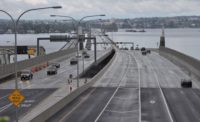Metro systems are vital circulatory systems for moving large numbers of residents, commuters and tourists around large cities. Metros are mass-transit systems that are generally heavy rail lines that operate on their own rights-of-way, whether underground, at grade or on elevated viaducts. They are distinct from light-rail and commuter rail networks.
According to the International Association of Public Transport (UITP), the world's 148 metro systems carry, every day, more than 150 million passengers on 540 lines over 11,000 kilometers to and from 9,000 stations.
Since the earliest metro systems were built more than 100 years ago, there have been many advances in their design. We will briefly recap a few of them.
In the 1960s, the St. Petersburg, Russia, subway was the first to introduce platform doors—that, is sliding glass doors at the edge of station platforms. Since platform doors allow subway stations to be air-conditioned, they played a more crucial role in the Singapore metro, which opened in 1987. "Singapore could not have an effective subway without platform doors" because of the city-state's tropical climate, says John Swanson, rail vehicle manager, central and western U.S. regions, Parsons Brinckerhoff Rail & Transit.
"Some cities are retrofitting platform doors, such as Copenhagen," explains Swanson. "The first London line with them, the Jubilee Line, opened in 1997. They are now really a standard in the industry [for new metros]." The Honolulu rapid transit system, which will open in 2017, also will have them.
The older subways have a much different feel, with lower ceilings and narrower entryways. "Recently built metros improve passenger flow by widening the ticket inspection areas and eliminating long passenger queues," adds Stuart Brunton, technical director of Parsons Brinckerhoff Rail & Transit. "Newer stations have a more human feel—advertising, color, materials and finishes. They have much more of an architectural flavor, with materials and lighting. And the new swipe card technology is opening things up a lot."
Passenger information systems also have come a long way. Today's transit traveller "wants real-time information, such as when is the next train coming, why is a train delayed, where are we or what is nearby," says Swanson. Current systems have features such as active passenger information displays inside the cars and external destination displays on the outside of the cars, he notes.
"You have to have high-capacity Wi-Fi and cell-phone connectivity now, which is a challenge in a tunnel system. It is not yet solved for deep tunnels," adds Swanson.
One less common innovation is automatic train operations, or driverless trains. This feature was first introduced on the London Underground's Victoria Line in 1967. "A number of Paris Metro lines are being converted to driverless operation, and conversion of the Nuremburg system is being done by Siemens," explains Brunton. "We have recently been working on Qatar's Doha system, [which] will come on line in 2020. It will be driverless. Trains will run at 90-second or two-minute intervals. Honolulu will be fully automated. It's the wave of the future. It gives you much more capacity."
In the U.S., a number of cities are engaged in major transit expansion projects. "I think the U.S. transit market is very good," says Michael Cobelli, chief operating officer of Skanska USA Civil. "The four leading cities are New York, Los Angeles, San Francisco and Baltimore."
























Post a comment to this article
Report Abusive Comment